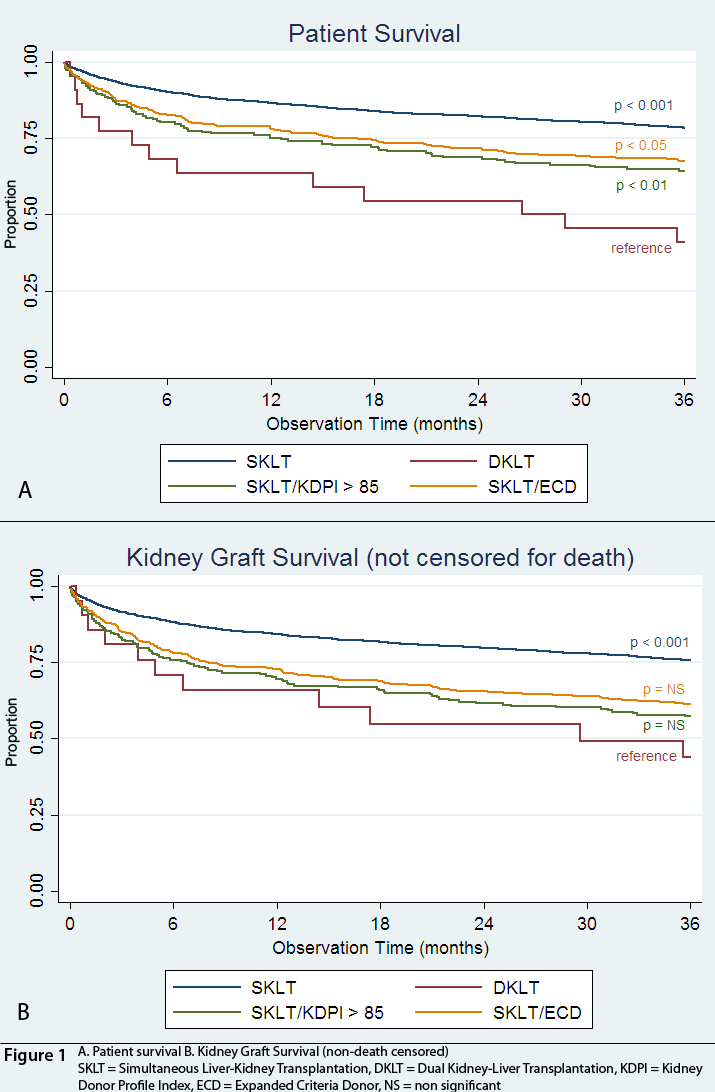Combined Dual-Kidney Liver Transplantation in the United States: A Review of UNOS/OPTN Data Between 2002 and 2012.
Department of Medicine, UCLA, Los Angeles, CA
Meeting: 2017 American Transplant Congress
Abstract number: D191
Keywords: Donors, Kidney/liver transplantation, marginal, Outcome
Session Information
Session Name: Poster Session D: Liver - Kidney Issues in Liver Transplantation
Session Type: Poster Session
Date: Tuesday, May 2, 2017
Session Time: 6:00pm-7:00pm
 Presentation Time: 6:00pm-7:00pm
Presentation Time: 6:00pm-7:00pm
Location: Hall D1
Background
Simultaneous liver-kidney transplantation (SLKT) has increased demand for donor kidneys during a national organ shortage. In kidney-alone recipients, dual kidney transplantation (DKT) using “marginal” donor organs has shown outcomes comparable to those of single-kidney transplantation using expanded criteria donor (ECD) organs. Here, we investigated combined dual-kidney liver transplantation (DKLT) in the United States.
Methods
We identified 22 DKLT and 3,044 SKLT performed in the United States between 2002 and 2012 using UNOS/OPTN registry data. Pediatric recipients, prior kidney or liver recipients, and other multi-organ transplant recipients were excluded. We compared donor/recipient data as well as graft/recipient survival between DKLT recipients and SKLT recipients of “marginal” kidneys [those from ECD and high kidney donor profile index (KDPI>85%) donors] over a 36-month period following transplant.
Results
When compared to ECD SKLT donors, DKLT donors had lower mean creatinine clearance (71 vs 88 mL/min, p<0.05) and longer kidney cold ischemia times (13.5 vs 11.8 hours, p<0.01), though mean KDPI and donor risk index (DRI) scores did not differ. DKLT donors also had longer cold ischemia times compared to high-KDPI SKLT donors (13.5 vs 11.0 hours, p<0.01). Recipients were similar with regards to age, MELD score, and dialysis dependence/duration. There was no difference in incidence of delayed graft function between groups. Recipient survival in the DKLT group at 36 months was inferior compared to both “marginal” organ SKLT recipient groups, while non-death censored graft survival did not differ (Figure 1). Death was the most common cause of graft loss in all groups.  Conclusions
Conclusions
Contrary to DKT data in kidney-alone recipients, DKLT recipients in our study had inferior survival when compared with SKLT recipients of “marginal” donor organs. These findings would suggest that dual kidney-liver transplantation has an uncertain role as a strategy to expand the existing kidney donor pool in combined transplantation. We would argue for caution in its routine use.
CITATION INFORMATION: Shekhtman G, Huang E, Lum E, Danovitch G, Pham P.-T, Abdalla B, Bunnapradist S. Combined Dual-Kidney Liver Transplantation in the United States: A Review of UNOS/OPTN Data Between 2002 and 2012. Am J Transplant. 2017;17 (suppl 3).
To cite this abstract in AMA style:
Shekhtman G, Huang E, Lum E, Danovitch G, Pham P-T, Abdalla B, Bunnapradist S. Combined Dual-Kidney Liver Transplantation in the United States: A Review of UNOS/OPTN Data Between 2002 and 2012. [abstract]. Am J Transplant. 2017; 17 (suppl 3). https://atcmeetingabstracts.com/abstract/combined-dual-kidney-liver-transplantation-in-the-united-states-a-review-of-unosoptn-data-between-2002-and-2012/. Accessed December 31, 2025.« Back to 2017 American Transplant Congress
